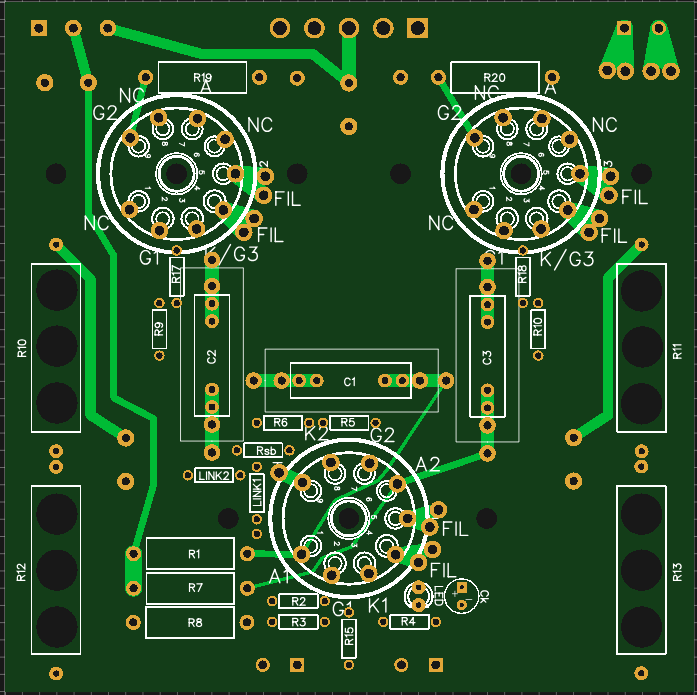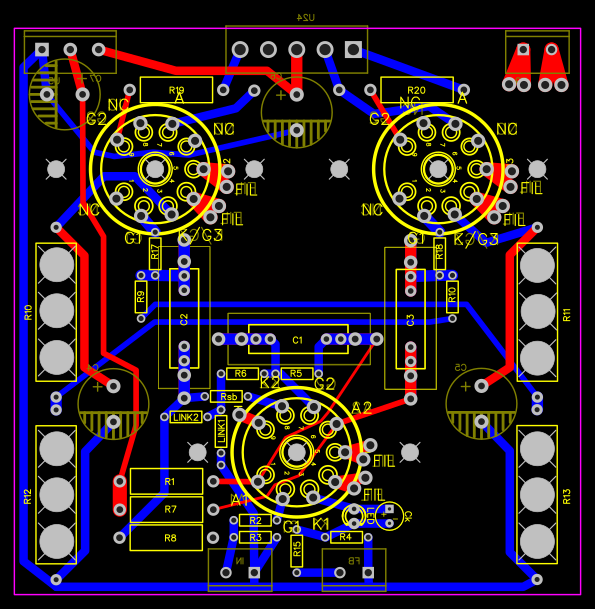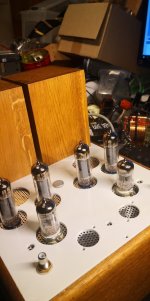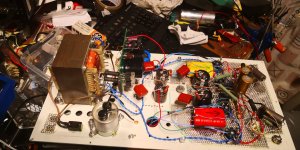For anybody interested, My version (variation?) of this design uses garter bias on the outout stage, and some GNFB to the cathode of the first tube. I'm working up a design for the PCB that will be universal- primarily intended to be used with EL84/6P14P, EL86/6CW5, and 6P43P-E triode connected outputs. I've incorporated options to wire the outputs as pentode, triode, or UL, and given some flexibility in biasing the input stage, with an unbypassed resistor, resistor/bypass cap, or LED. Sort of an experimenters' playground, spurred on by the availability of affordable 6N1P, 6N2P, 6P14P, and 6P43P-E tubes, and others. I happen to have twenty or so 6P43P-E that I am intending to build up triode connected that these PCB's seem especially handy for 🙂


If interested in checking it out, swing by my thread on the 6N2P/6CW5 build, and suggestions are welcome!
6N2P/6CW5 design with toroidal outputs
If interested in checking it out, swing by my thread on the 6N2P/6CW5 build, and suggestions are welcome!
6N2P/6CW5 design with toroidal outputs
Its easily on a par with the F5s that I've built
a good EL84 should be a clear winner over F5 wherever the power is not a must, my 2 cents
I dunno... real class-a has a magic all its own.
And a little extra power never hurts, even if only to keep it away from clipping.
And a little extra power never hurts, even if only to keep it away from clipping.
Eh.
Depends on the exact setup. Some speakers sound better with different amplifiers.
An F4 or F5 is a formidable match on many speakers, but it's a different "sound" for sure. (And a nice one!)
Depends on the exact setup. Some speakers sound better with different amplifiers.
An F4 or F5 is a formidable match on many speakers, but it's a different "sound" for sure. (And a nice one!)
I'm working up a design for the PCB that will be universal- primarily intended to be used with EL84/6P14P, EL86/6CW5, and 6P43P-E triode connected outputs. I've incorporated options to wire the outputs as pentode, triode, or UL, and given some flexibility in biasing the input stage, with an unbypassed resistor, resistor/bypass cap, or LED. Sort of an experimenters' playground, spurred on by the availability of affordable 6N1P, 6N2P, 6P14P, and 6P43P-E tubes, and others. I happen to have twenty or so 6P43P-E that I am intending to build up triode connected that these PCB's seem especially handy for 🙂
I’m very interested in your effort here, and appreciate your desire for tube and OT connection flexibility. I have a box full of EL86 tubes, mostly good Euro version, that I would like to put to good use.
Anyone care to explain this to me?The operating point of the phase inverter is not really optimum IMHO. I'd aim for something like 100V on the cathode of the split load inverter by adjusting the value of the lower 1M to something like 1.5M
I'd be interested. I'm building one right now.p2p. But would love to build friends pcb versions of this.. I'm working up a design for the PCB that will be universal- primarily intended to be used with EL84/6P14P, EL86/6CW5, and 6P43P-E triode connected outputs.
I might be ordering PCB prototypes soon, once I build one up I'll post more in my 6n2p/6CW5 thread. I think I'll have six designs to test coming in soon 😱
(a couple aren't audio related, but for LED lighting for aquarium uses, audio wise there's a crossover board, the universal push-pull noval as well as a stereo noval SE board, fun stuff)
(a couple aren't audio related, but for LED lighting for aquarium uses, audio wise there's a crossover board, the universal push-pull noval as well as a stereo noval SE board, fun stuff)
F4, F5 and the last version are amps with 0 aggressiveness. IDK how a el84 would do vs them.... I know what I prefer, neither.
Recently, I was working on some modified SRPP with and without cathode resistor bypass... and to my shocking discovery in the 0 global feedback design the bypass hurts the sound by coloration and a distinct distortion sound similar to S.E.T in the bass (not very bad) and a very solid state like audible high pitch very distorted glare in sopranos voice, this was not my speakers but revealed very well by the scan-speak tweeter... however this is at the price of a higher output Z, not sure you want to do this in a POWER amp, but in pre-sections I am re-thinking my whole philosophy. In power amp, grid-bias is good.
My philosophy in power amps is to use grid-bias at all stages and moderate feedback.
Recently, I was working on some modified SRPP with and without cathode resistor bypass... and to my shocking discovery in the 0 global feedback design the bypass hurts the sound by coloration and a distinct distortion sound similar to S.E.T in the bass (not very bad) and a very solid state like audible high pitch very distorted glare in sopranos voice, this was not my speakers but revealed very well by the scan-speak tweeter... however this is at the price of a higher output Z, not sure you want to do this in a POWER amp, but in pre-sections I am re-thinking my whole philosophy. In power amp, grid-bias is good.
My philosophy in power amps is to use grid-bias at all stages and moderate feedback.
Last edited:
A bit difficult to see, somewhat blurry ... resistor to ground from the RCA ground tab instead of going directly to ground ?  😀
😀
Best regards, Claas
 😀
😀Best regards, Claas
Well done Claas. Should have ground of rca going to ground. And that resistor to rca signal from ground.
By chance has any been able to compare the original TCJ version to the RH84? Two completely different approaches to getting about 5W of power but I have an application for which either might work. In this particular application it would not be required to cover the sub 70Hz range.
I have heard that PP handles thick complex instrumentation (think romantic era symphonies) better than SE but I have not noticed a problem with my SEUL KT88 with plate to plate in such circumstances. So obviously the distortion spectrum will be different and the PP will generate more heat but I am curious as to what differences to expect sound wise. Especially interested in those who have heard both.
For those unfamiliar the RH84 is Se pentode mode with plate to plate feedback.
I have heard that PP handles thick complex instrumentation (think romantic era symphonies) better than SE but I have not noticed a problem with my SEUL KT88 with plate to plate in such circumstances. So obviously the distortion spectrum will be different and the PP will generate more heat but I am curious as to what differences to expect sound wise. Especially interested in those who have heard both.
For those unfamiliar the RH84 is Se pentode mode with plate to plate feedback.
Last edited:
She's finished. And she's a keeper. Replace the first tube cathode resistor with silicon carbide diode. STPSC2H12D did think that was a slight improvement. Still have to try the lm317's in the tail.
Gorgeous!
By chance has any been able to compare the original TCJ version to the RH84? Two completely different approaches to getting about 5W of power but I have an application for which either might work. In this particular application it would not be required to cover the sub 70Hz range.
I have heard that PP handles thick complex instrumentation (think romantic era symphonies) better than SE but I have not noticed a problem with my SEUL KT88 with plate to plate in such circumstances. So obviously the distortion spectrum will be different and the PP will generate more heat but I am curious as to what differences to expect sound wise. Especially interested in those who have heard both.
For those unfamiliar the RH84 is Se pentode mode with plate to plate feedback.
The TCJ amplifier is leagues ahead of the RH84. I've built the RH84 a couple times and didn't care for it, it sounded soggy and wasn't as tight at all.
TCJ??
Whazzat?
It's the shorthand people use to refer to the Tubecad journal el84 amp that is the topic of the thread
- Home
- Amplifiers
- Tubes / Valves
- Unexpectedly good EL84 amp

